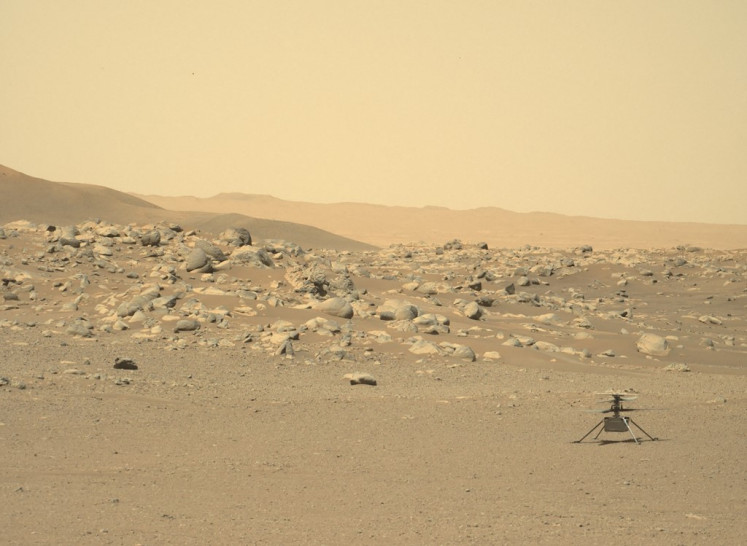SpaceX launches most powerful Falcon 9 yet
The rocket is designed to require far less maintenance and refurbishment between flights, and is certified to carry humans to space later this year when SpaceX launches its Dragon crew capsule to the International Space Station.
Change Size
 This NASA photo released April 19, 2018 shows a SpaceX Falcon 9 rocket soaring upward after lifting off from Space Launch Complex 40 at Cape Canaveral Air Force Station in Florida, carrying NASA's Transiting Exoplanet Survey Satellite (TESS)on April 18, 2018. Liftoff was at 6:51 p.m. EDT. TESS will search for planets outside of our solar system. The mission will find exoplanets that periodically block part of the light from their host stars, events called transits. The satellite will survey the nearest and brightest stars for two years to search for transiting exoplanets. (AFP Photo/NASA/Kim Shiflett)
This NASA photo released April 19, 2018 shows a SpaceX Falcon 9 rocket soaring upward after lifting off from Space Launch Complex 40 at Cape Canaveral Air Force Station in Florida, carrying NASA's Transiting Exoplanet Survey Satellite (TESS)on April 18, 2018. Liftoff was at 6:51 p.m. EDT. TESS will search for planets outside of our solar system. The mission will find exoplanets that periodically block part of the light from their host stars, events called transits. The satellite will survey the nearest and brightest stars for two years to search for transiting exoplanets. (AFP Photo/NASA/Kim Shiflett)
S
paceX on Friday blasted off its newest and most powerful Falcon 9 rocket, known as the Block 5, carrying the first high-orbit communications satellite for Bangladesh and marking a leap forward in re-usability for the California-based aerospace company.
The rocket is designed to require far less maintenance and refurbishment between flights, and is certified to carry humans to space later this year when SpaceX launches its Dragon crew capsule to the International Space Station.
"Three, two one, zero, ignition, liftoff," a SpaceX commentator said as the rocket launched at 4:14 pm (2014 GMT) from Cape Canaveral, Florida.
The Block 5 Falcon 9 rocket's main goal for its maiden mission was to propel a communications satellite for Bangladesh, called Bangabandhu Satellite-1, to a geostationary transfer orbit roughly 22,000 miles (35,000 kilometers) above Earth.
"In the continuous advancement of Bangladesh another milestone is added today," said Bangladesh Prime Minister Sheikh Hasina in a video address aired on SpaceX's launch webcast.
"With the launch of Bangabandhu-1, we are hoisting our national flag into space."
The satellite will offer video and communications coverage over Bangladesh and its territorial waters in the Bay of Bengal, as well as in India, Nepal, Bhutan, Sri Lanka, the Philippines, and Indonesia.
"The satellite will also provide broadband connectivity to rural areas throughout the country," said a SpaceX statement, noting that the mission is expected to last at least 15 years.
About a half hour after launch, live images showed the satellite drifting into the inky blackness of space, as cheers and screams erupted at SpaceX headquarters in Hawthorne, California.
"Successful deployment of Bangabandhu Satellite-1 to geostationary transfer orbit," SpaceX said on Twitter.
Read also: SpaceX poised for 50th launch of Falcon 9 rocket
- 'Crazy hard' -
The launch was postponed at the last minute Thursday, when an automatic abort switch was triggered, but SpaceX said it was just a glitch and the spacecraft remained in good health.
The rocket is built to re-fly up to 10 times with minimal refurbishment, SpaceX CEO Elon Musk told reporters ahead of the launch.
"We expect there would be literally no action taken between flights, so just like aircraft," Musk said, describing the many years of effort that went into the rocket as "crazy hard."
After liftoff, the rocket made a successful upright landing on the "Of Course I Still Love You" droneship stationed in the Atlantic Ocean, marking the 25th successful touchdown for SpaceX.
SpaceX has now landed 11 of its boosters on land and 14 on its droneships, which are floating platforms in the ocean, as part of its effort to bring down the cost of spaceflight and re-use costly rocket parts.
The first crew launch for SpaceX is tentatively planned for December 2018.
It will mark the first time since the end of the US space shuttle program in 2011 that a rocket has left US soil carrying people to space.







